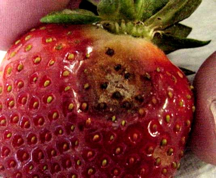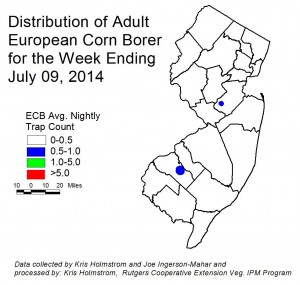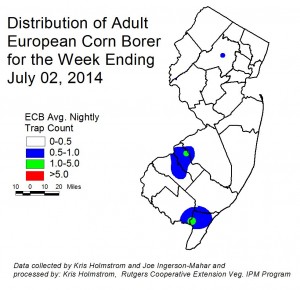Vegetable IPM Report 7-9-14 – Click to View | Download | Print
Maps for the Week
–European Corn Borer Map
–Corn Earworm Moth Blacklight Trap Map
–Corn Earworm Moth Pheromone Trap MapTopics for the Week
- Sweet Corn
- Peppers
- Pepper Weevil Report
- Tomatoes
- BMSB
- Pumpkins and Winter Squash
Search Results for: pepper anthracnose'
Veg IPM Update: Week Ending 7/9/14
Veg IPM Update: Week Ending 7/2/14
Vegetable IPM Report 7-2-14 – Click to View | Download | Print
Maps for the Week
–European Corn Borer Map
–Corn Earworm Moth Pheromone Trap MapTopics for the Week
- Sweet Corn
- Peppers
- Pepper Weevil Report
- Tomatoes
- BMSB
- Pumpkins and Winter Squash
Strawberry Fruit Rots

Anthracnose Fruit Rot of Strawberry
Pathogens such as anthracnose, gray mold (Botrytis), and leather rot can become systemic problems in strawberry plantings once established. All three fungal diseases are soil-borne and once in fields can be difficult to manage over the lifetime of the planting.
The use of mulch (matted rows) to prevent/reduce soil splashing and keeping fruit from coming into direct contact with the soil surface can be beneficial in organic production systems where conventional fungicides cannot be used. Use of long crop rotations and staying away from areas of the farm with known instances of any of these pathogens is also important. Remember that same species of Colletotrichum that causes fruit rot in pepper and other crops can also infect strawberry.
Vegetable Disease Update – 9/13/13
|
|
Carrots
Leaf blights – Powdery mildew, Alternaria and Cercospora. Alternaria and Cercospora are two soil-borne fungal pathogens that may cause early defoliation in carrots reducing yields and making harvest difficult. Both pathogens produce distinct symptoms on carrots. Powdery mildew causes characteristic white, powdery lesions on foliage. Symptoms of Alternaria include irregular, dark brown to black spots which typically show up on older leaves first. Cercospora leaf spots are round, grayish-brown and are more prevalent on younger foliage. Both leaf blights typically start at the margins of leaflets and as more spots develop leaflets begin to wither and die. Symptoms similar to leaf infections can develop on stems and petioles.
Control of both diseases begins with regular scouting and preventative fungicide applications on susceptible varieties. Apply Quadris (azoxystrobin, 11) at 9.0 to 15.5 fl. oz 2.08F/A, or Cabrio 20EG (pyraclostrobin, 11) at 8.0 to 12.0 oz/A, or Pristine (pyraclostrobin + boscalid, 11 +7) at 8.0 to 10.5 oz 38WG/A tank-mixed or alternated with chlorothalonil (M5) at 1.5 to 2 pt/A. For Alternaria only: Apply a tank mix of 1.5 to 2.0 pt/A chlorothalonil plus Endura (boscalid, 70 at 4.5 oz 70W/A, or Switch (cyprodinil + fludioxonil, 9 +12) at 11.0 to 14.0 oz 62.5WG/A, or iprodione at 1.0 to 2.0 pt 50WP/A. For more information on tolerant varieties and control please the 2013 New Jersey Commercial Vegetable Production Recommendations. [Read more…]
Vegetable Disease Brief – 9/4/13
There have been no new reports of Late blight.
Asparagus – Summer foliar diseases in Asparagus have been reported. With the cooler weather and all the rain we’ve have been experiencing on and off all summer disease pressure in asparagus is higher than normal (see article). [Read more…]
Vegetable Disease Update 8/16/13
No Late blight has been reported in New Jersey this week.
Cucurbit downy mildew remains active.
White speck (or Plectosporium blight) has been reported in pumpkin. [Read more…]


